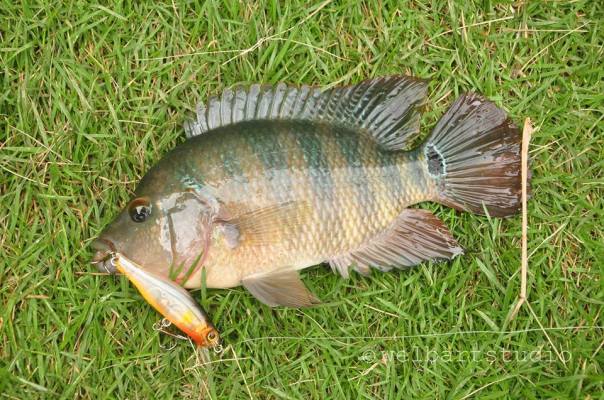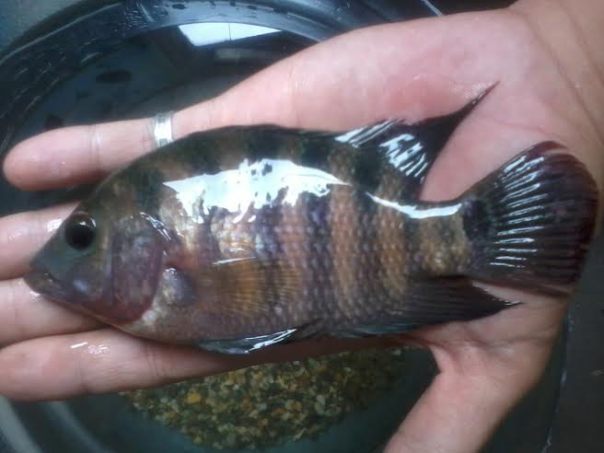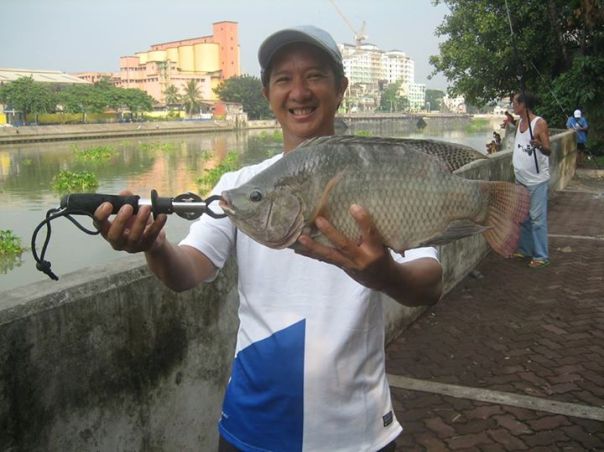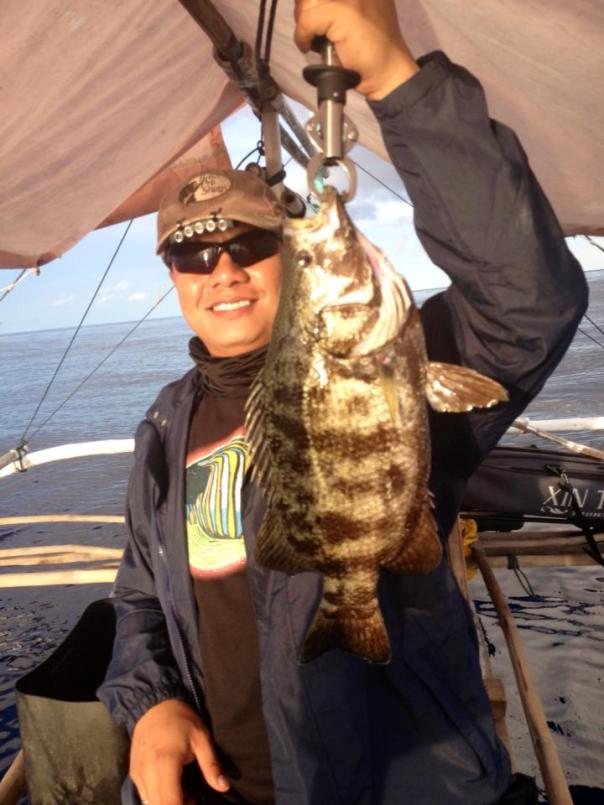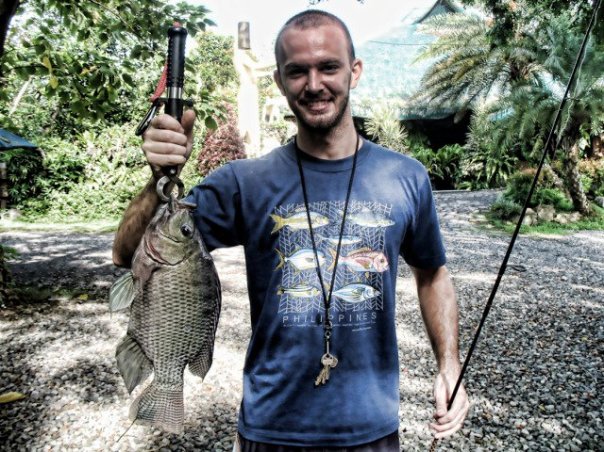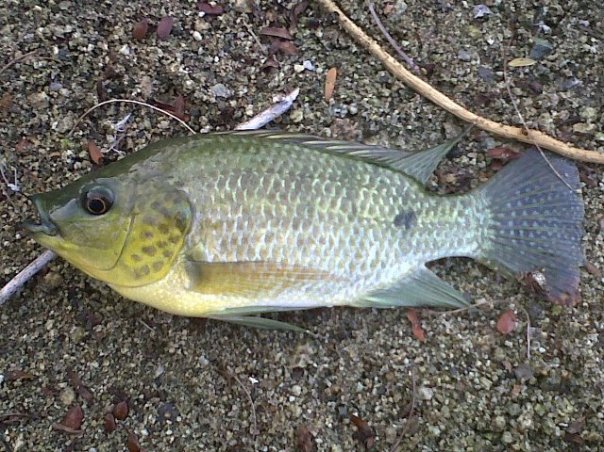Category Archives: Tilapia
Mayan Cichlid ( Cichlasoma urophthalmus )
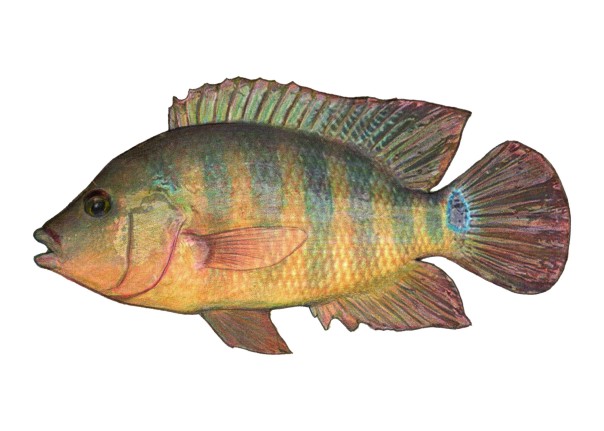
Common Name: Mexican Mojarra, Tilapia (mis-identified)
Local Name: ??? (Tagalog); ??? (Cebuano)
Max Size: 39.4 cm (1.1 kg)
Biodiversity: Freshwater, Brackish, Introduced
Depth: 0 – ?? m
Fishing Season: All Year Long
Minimum Size Limit: none
Recommended Bait/Lures: Shrimp, Worms, Small Fish, Insects
IUCN Red List Status: Not Evaluated (NE)
Mayan Cichlids have been reported in central Luzon as established in many local waterways. This species is originally from South America and has been transferred around the globe through the aquarium trade. That is undoubtedly how it found its way to the waters of the Philippines. It is likely that this species will spread throughout the country and become well established.
These cichlids are look very similar to tilapia only they have a more brownish and reddish color and a spot on their tail. They also have eight bars along their bodies which can help identify them. Anglers are most likely to catch these in the Provinces of Pampanga and Bulacan when fishing in freshwater for tilapia or brackish water fish. Mayan Cichlids make good food fish and can be fished for as gamefish.
Monster Tilapia from the Pasig
Here is an amazing catch from the Pasig River in Metro Manila. This is a 2 kg Pla-pla or Nile Tilapia ( Oreochromis niloticus ) caught by Bipoy. This is undoubtedly an escaped convict from one of the fish pens in Laguna Lake as these fish are not native to the Philippines. Anglers catch tilapia, knife fish, sea catfish, and many other species of fish in the Pasig. It is great to see this river that was once considered “dead” because of pollution to have great signs of life.
Have you caught a nice fish in the Pasig? Send us your photos and we will share them here.
<><
Tripletail ( Lobotes surinamensis )
Common Name: Tripletail
Local Name: Tilapiang Dagat (Tagalog), Gingao, Ligad (Cebuano)
Max Size: 110 cm ( 19.2 kgs )
Biodiversity: Marine, Brackish, Benthopelagic, Oceanodromous, Endemic
Depth: 1 – 70m
Fishing Season: All Year Long
Minimum Size Limit: 15 inches
The fish in these pictures were caught off Dumaguete, Negros Oriental around FADs (fish aggregating devices) or buoys. These fish can be caught along the coast as well. Yet another one of the many game fish species that can be caught here .
Crocolandia
For those looking for a real laid back fishing experience in small ponds full of fish there is Crocolandia. It is a zoo/animal rescue and conservation effort that is located in Biasong, Talisay City, just south of Cebu City. Here is a map of the spot:
PROS:
Great place for family fishing trip
Benches to sit Shaded fishing area, Snack bar, other animals to see
Lots of fish and some big ones too
Bamboo poles available at no extra cost
CONS:
Only two small ponds to fish
Entrance fee (kids-50php, adults-100)
FISH SPECIES:
Tilapia, Red Pacu, Striped Snakeheads and possibly others
DESCRIPTION:
Crocolandia was started as a sanctuary for the fast disappearing species of Philippines saltwater crocs and alligators. It has since expanded to include a wide variety of both native and introduced species of animals. They have resident biologists and consulting vetrenarians that ensure that the animals, birds and reptiles are healthy and well taken care of.
The fishing ponds at Crocolandia are a relatively new addition to the zoo and provide another fun activity there. The ponds are relatively small and are not that deep but they do hold an abundance of tilapia, snakehead and large pacu. To fish there at Crocolandia just inform the staff and they will assist you.
You can keep the fish that you catch there and purchase them to bring home. However we also recommend that you release the snakeheads to hep keep the already booming population of small tilapia at bay.
RATING:
( 6/10 ) I rate this spot as a 6 because I prefer fishing in natural wild environments. However if you are looking for a fun spot to take the family this place is excellent.
REMINDERS:
Don’t forget about the entrance fee.
Ask for a guided tour of the zoo to learn a lot of interesting stuff about the animals.
Say Hi to Lapu-Lapu, the largest Croc that is there. If you are lucky you may catch them at feeding time.
PHOTOS:
Here is their well kept Facebook page: https://www.facebook.com/Crocolandia
Nile Tilapia ( Oreochromis niloticus )
Common Name: Tilapia
Local Name: Pla pla (Tagalog), Tilapia(Cebuano)
Max Size:
Biodiversity: Marine, Brackish, Freshwater, Introduced
Depth: 0 – 6 meters
Fishing Season: All Year Long
This is one of the larger growing tilapia species that can be caught in Philippines waters. It is a species that reportedly was introduced into the Philippines in 1972 as a food fish which has been released into many bodies of water deliberately or indirectly by these fish escaping from fish pens. These fish are primarily herbivores and can grow over 3kgs in weight. They also do occasionally take other baits such as worms, and even small lures. This 1.2kg fish took a Berkley plastic trout worm that I wacky rigged on a weightless hook. This fish are excellent food fish and are now a common food fish on Luzon. I have come to see though that these fish are not as highly valued by the Visayas probably due to the vast amount to saltwater fish available.
Blackchin Tilapia ( Sarotherodon melanotheron )
Common Name: Tilapia,
Local Name: Gloria, Tilapiyang Arroyo (Tagalog), ?? (Cebuano)
Status: Introduced
Max Size: 28 cm
Biodiversity: Marine, Brackish, Freshwater
Depth: 1 – ?? m
Fishing Season: All Year Long
Minimum Size Limit: none
Recommended Bait/Lures: Masa (dough bait), Algae, worms
IUCN Red List Status: Not Evaluated (NE)
This is a species of Tilapia native to Africa that was introduced into the waters of the Philippines by unknown means presumably for use in the aquaculture industry. BFAR denies any knowledge of the species introduction and has classified this fish as a invasive exotic species. It is a unique tilapia species due to its ability to tolerate high salinity. It can be found in many places around the Philippines where it has become well established and even a potential threat. Manila Bay and Bataan are two place where these fish have taken over. This fish is also present in Cebu City.
The local names of this species; Gloria and Tilapiyang Arroyo, are attributed to a former president of the Philippines, Gloria Macapagal-Arroyo. The Blackchin’s small size is compared to the former presidents petite size, and the black spots on the snout of the fish are compared to a prominent mole on her face.
Gloria can be caught by anglers using bait, which makes them useful for the fishing community. Though they are small in size, often only reaching 4 inches, they can still be utilized as a food fish. Anglers are encouraged not to release these fish if they catch them and instead to eat them or dispose of them in another way. Some anglers also use small Gloria for bait for larger fish in both saltwater and freshwater.
Red Bellied Tilapia (Tilapia Zillii)
Common Name: Tilapia,
Local Name: Tilapia (Tagalog); Tilapia (Cebuano)
Max Size: 40 cm
Biodiversity: Freshwater, Brackish
Depth: 1 – 7 m
Fishing Season: All Year Long
Minimum Size Limit: 6 inches
Recommended Bait/Lures: Worms, Masa (doughbait), algae; flies
IUCN Red List Status: Not Evaluated (NE)
I went fishing this morning in the Mabacan River hoping to catch some carp that I have heard inhabit our area. I was not able to catch any carp, though I was able to hook this tilapia on a doughball and corn. I think I am now convinced that these are Red Bellied Tilapia in our river. There may be other species as well, but this is the only one that I can identify with certainty. These are an introduced species.
Tilapia
There are many varieties of Tilapia that can be caught in the country. All of these species were introduced. Tilapia can be difficult to catch at times because they primarily feed on vegetation. I have fished for them in may lakes and rivers here in laguna and have caught them on many different things including worms, doughballs, corn, spinners, small plastic worms, flys, and more. The first Tilapia is a 9″er that I caught in the Mabacan River on a worm. The larger tilapia are known in this area as Pla pla.
